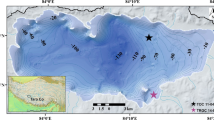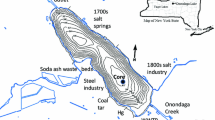Abstract
Slapton Ley, a coastal lake in SW England, has been shown by a variety of paleolimnological studies, to have become increasingly eutrophic in the period since 1950 AD. Since that time, intensification of agriculture has resulted in increased erosion of topsoil from fields in the catchment of the Ley. Sediment accumulation rates, as estimated by 210Pb-dating and multiple core correlation of peaks in whole core volume magnetic susceptibility, are equivalent to a catchment erosion rate of 13.4 t km−2 a−1, which figure agrees well with directly monitored data. Diatom and chlorophyll a analysis of the uppermost sediments shows that the Ley has recently experienced a major shift in its trophic status, changing from a clear water, macrophyte lake to one dominated by plankton in a hypertrophic system. This last point is further amplified in the paper by Heathwaite & O'Sullivan (1991).
Similar content being viewed by others
References
Acott, T. G., 1989. An investigation into nitrogen and phosphorus loadings on Slapton Ley, 1905–1985. unpublished BSc dissertation. Polytechnic South West.
Appleby, P. G. & F. Oldfield, 1978. The calculation of 210Pb dates assuming a constant rate of supply of unsupported 210Pb to the sediment. Catena 5: 1–8.
Benson-Evans, K., D. Fish, G. Pickup & P. Davies, 1967. The natural history of Slapton Ley Nature Reserve. II — Preliminary studies of the freshwater algae. Field Studies 2: 493–519.
Brookfield, D., 1981. Chemical analysis of lake sediment from Slapton Ley. unpublished BSc dissertation, Polytechnic South West.
Crabtree, K. & F. E. Round, 1967. Analysis of a core from Slapton Ley. New Phytol. 66: 255–270.
Click, M. W., 1985. Investigation into the relationship between sediment accumulation in the Lower Ley (Slapton), and spatial patterns of erosion within its catchment. unpublished BSc dissertation, Polytechnic South West.
Dearing, J. A., 1983. Changing patterns of sediment accumulation in a small lake in Scania, Southern Sweden. In Paleolimnology (J. Meriläinen, P. Huttunen & R. W. Battarbee, eds), Dr W. Junk bv, The Hague.
Foster, I. D. L., J. A. Dearing, A. A. Simpson, A. D. Carter & P. G. Appleby, 1985. Lake-catchment-based studies of erosion and denudation in the Merevale catchment, Warwickshire, UK. Earth Surface Processes & Landforms. 10: 45–68.
Hails, J. R., 1975. Some aspects of the Quaternary history of Start Bay, Devon. Field Studies 4: 207–222.
Heathwaite, A. L. & P. E. O'Sullivan, 1990. Sequential inorganic chemical analysis of a core from Slapton Ley. Hydrobiologia, this volume.
Johnes, P. J. & P. E. O'Sullivan, 1989. The Natural History of Slapton Ley Nature Reserve. XVIII — Nitrogen and phosphorus losses from the catchment — an export coefficient approach. Field Studies 7: 285–309.
Morey, C. R., 1976. The Natural History of Slapton Ley Nature Reserve. IX — The morphology and history of the lake basins. Field Studies 4: 353–368.
Moscrop, C., 1986. A diatom profile from recent sediments in Slapton Ley. unpublished BSc dissertation, Polytechnic South West.
Moss, B., 1983. The Norfolk Broadland: experiments in the restoration of a complex wetland. Biol. Revs. 58: 521–561.
Oldfield, F. & P. G. Appleby, 1984. Empirical testing of 210Pb dating models for lake sediments. — In Lake Sediments and Environmental History, E. Y. Haworth & J. W. G. Lund (eds) Butterworth: 93–124.
O'Sullivan, P. E., Coard, M. A. & D. A. Pickering, 1982. The use of laminated lake sediments in the estimation and calibration of erosion rates — in Recent developments in the explanation and prediction of erosion and sediment yield (Proceedings of the Exeter Symposium, July 1982) IASH publ. no. 137: 385–396.
O'Sullivan, P. E., A. L. Heathwaite, K. M. Farr & J. P. Smith, 1989. Southwest England and the Shropshire-Cheshire meres. Guide to Excursion A, Vth International Symposium on Paleolimnology, Ambleside, Cumbria, 1–6 September, 1989.
Stanes, R., 1983. A Fortunate Place: a history of Slapton in South Devon. Field Studies Council, London.
Trudgill, S. T., 1983. The Natural History of Slapton Ley Nature Reserve. XVI — The soils of Slapton Wood. Field Studies 5: 833–840.
Van Vlymen, C. D., 1980. The water balance, physicochemical environment, and phytoplankton studies of Slapton Ley, Devon. PhD thesis, University of Exeter.
Author information
Authors and Affiliations
Rights and permissions
About this article
Cite this article
O'Sullivan, P.E., Heathwaite, A.L., Appleby, P.G. et al. Paleolimnology of Slapton Ley, Devon, UK. Hydrobiologia 214, 115–124 (1991). https://doi.org/10.1007/BF00050940
Issue Date:
DOI: https://doi.org/10.1007/BF00050940




